-
Paper Information
- Previous Paper
- Paper Submission
-
Journal Information
- About This Journal
- Editorial Board
- Current Issue
- Archive
- Author Guidelines
- Contact Us
International Journal of Genetic Engineering
p-ISSN: 2167-7239 e-ISSN: 2167-7220
2025; 13(2): 24-29
doi:10.5923/j.ijge.20251302.02
Received: Jan. 28, 2025; Accepted: Feb. 17, 2025; Published: Feb. 28, 2025

The Influence of Atmospheric Physical Parameters on the Diversity of Tiger Beetles (Coleoptera: Cicindelidae)
Mamatova Malokhat M.1, Mirzaeva Gulnara S.2
1National University of Uzbekistan, Tashkent, Uzbekistan
2Institute of Zoology of the Academy of Sciences of the Republic of Uzbekistan, Tashkent, Uzbekistan
Copyright © 2025 The Author(s). Published by Scientific & Academic Publishing.
This work is licensed under the Creative Commons Attribution International License (CC BY).
http://creativecommons.org/licenses/by/4.0/

This article highlights the analysis of the extent to which ecological factors affect the distribution of the tiger beetles population in the regions during the research conducted in Surkhandarya and Kashkadarya regions in 2023-2024. Furthermore, it clarifies the extent to which tiger beetles respond to any changes in the environment, especially changes in their distribution area and number with changes in temperature and humidity. Since the average temperature on the soil surface from the third decade of March was sufficient for the beetles to switch to an active lifestyle, they began the breeding season. In April - May, an optimal environment for the beetles’ life was created, i.e., the average air temperature was 15-20°C and the humidity was 50-35%, which also created favorable conditions for insects that serve as food for tiger beetles. This, in turn, created the basis for the transition of the population of representatives of this family to an active lifestyle. During our research, the distribution and ecology of the species Megacephala euphratica Dejean in Latreille & Dejean, 1822, Cicindela turkestanica turkestanica Ballion, 1876, Cicindela clypeata clypeata Fischar von Waldheim, 1821, Calomera littoralis Fabricius, 1787 were studied across landscapes, and it was analyzed that the period when the beetle population is most active falls on May.
Keywords: Tiger beetles, Climate, Southern Uzbekistan, Population, Landscape, Range
Cite this paper: Mamatova Malokhat M., Mirzaeva Gulnara S., The Influence of Atmospheric Physical Parameters on the Diversity of Tiger Beetles (Coleoptera: Cicindelidae), International Journal of Genetic Engineering, Vol. 13 No. 2, 2025, pp. 24-29. doi: 10.5923/j.ijge.20251302.02.
Article Outline
1. Introduction
- The tiger beetles (Coleoptera: Cicindelidae) are zoophagous in both larval and adult stages, with each species specializing in a narrow range of habitats. Currently, the population of this family is declining almost worldwide due to the impact of natural or anthropogenic factors on their habitat [9,13,19].Among the various habitat parameters that play an important role in the distribution of Cicindelidae in nature, physical, chemical and climatic components, including soil composition, moisture, temperature, as well as vegetation cover, are of great importance [2,6,17]. Recently, attempts have been made to overcome the problem by using insects instead of vertebrates as indicators [18]. In particular, the most important role of the Cicindelidae family is as an indicator of regional patterns of biodiversity [3,5,14,15], and studies of the effects of natural habitat development on insects have shown that many species are not well adapted to artificial habitats [16]. Historically, population losses due to natural disturbances have often been temporary, with adults from nearby populations repopulating the affected areas. However, as human activities have increasingly destroyed populations, the metapopulation dynamics of the Cicindelidae have been disrupted, leading to their widespread extinction [6,8]. Unfortunately, much of the coastal habitat that is currently considered suitable for the Cicindelidae has been affected by anthropogenic activities. Only wetlands and areas unsuitable for agriculture or other activities are largely intact [18].
2. Materials and Methods
- The highest diversity of this insect group can be observed in areas with high average annual temperatures, high humidity, and a large mosaic of habitats, in particular, in various sandy areas favorable for many species of Cicindelidae. As a result, the number of species of tiger beetles found in warm tropical regions is much higher than in desert regions [1,2,8,14].Studies on the influence of humidity and temperature factors on tiger beetles were conducted from March to September 2023 and from the third decade of March to the third decade of June 2024 in several districts of Surkhandarya and Kashkadarya regions in different landscapes. During the studies, insect samples were collected using entomological traps (sachok) and the route method (manual picking). In the study of nocturnal species, light traps were used, in which the light traps were placed from late afternoon to early morning, and spiral, energy-saving fluorescent and ultraviolet-emitting lamps were used [21; pp. 52-53]. Insects caught in the traps were collected into containers through a special funnel. Material collection was carried out in natural biocenoses during short-term (5-7-day) expeditions organized twice a month.To identify insects at the species level, samples from the entomology collection of the Institute of Zoology of the Academy of Sciences of the Republic of Uzbekistan, as well as data from the Carabcat databases [11], were used.
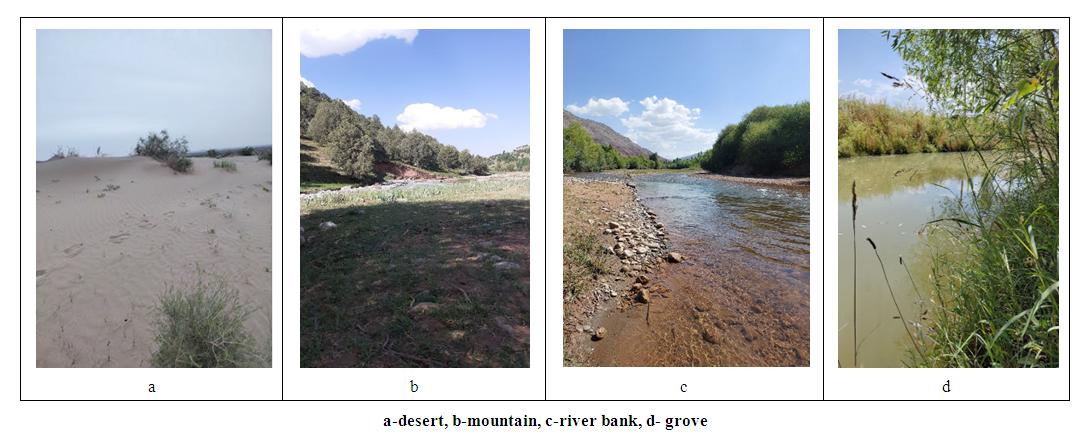 | Figure 1. Landscapes, where tiger beetles were encountered |
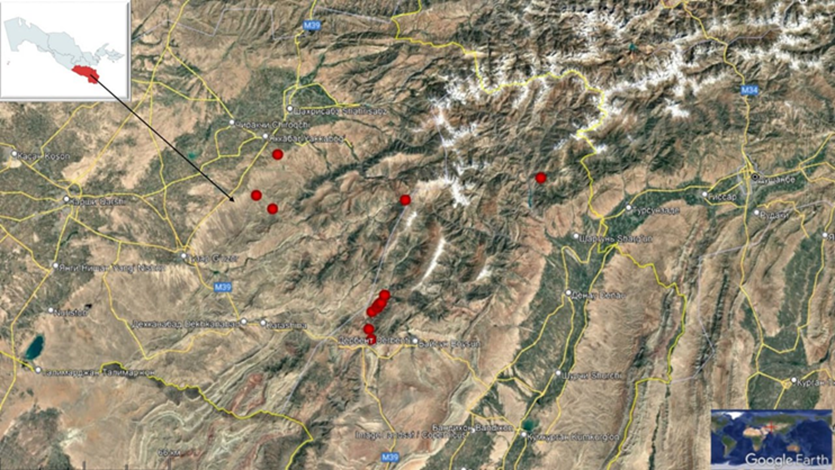 | Figure 2. Areas, where research was conducted in Kashkadarya and Surkhandarya regions (2023-2024 yy.) |
3. Obtained Results
- During the research work conducted in the Surkhandarya and Kashkadarya regions in 2023-2024, in order to more fully study the bioecology of the tiger beetles of Southern Uzbekistan, we analyzed the extent to which ecological factors affect the distribution of beetle populations in these regions. It is known from the literature that tiger beetles quickly respond to any changes in the environment, especially with changes in temperature and humidity, their distribution area also changes.During our research, we paid special attention to the fact that the beetles were found in landscapes that were not significantly affected by the human factor: around reservoirs, pastures, river headwaters, and desert areas, which are not developed for agriculture.Systematic list of species identified in the research:Family: Cicindelidae Latreille, 1802Tribe: Megacephalini Laporte, 1834Genus: Grammognatha Motschulsky, 1850 Megacephala euphratica Dejean in Latreille, 1822 Registered location: Surkhandarya region. Termiz district, 37°15′24.2″N, 67°25′34.67″E in the desert areas 11– 12.V.2024, 1♀.Distribution: Southeastern Europe, North Africa, Southwestern and Central Asia, including Uzbekistan [11,20]. Tribe: Cicindelini Latreille, 1802Genus: Cicindela Linnaeus, 1758Cicindela (Calomera) littoralis Fabricius, 1787Registered location: Surkhandarya region. Sherobod district, 37º95'09.76" N, 66º84'15.20" E, hill zone, 11– 12.V.2023 -1 ♂.Distribution: Eurasian region, including Afghanistan, Iran, Kazakhstan, Kyrgyzstan, Turkmenistan, Tajikistan, Uzbekistan [11].Cicindela turkestanica turkestanica Ballion, 1876Registered location: Kashkadarya region. Dehkonobod district, Dukonkhona village, 38°40′47.92" N, 67°16′18.29" E, mountain ecosystem, riverbank, 11– 12.IV.2024,1 ♂,1♀.Distribution: Afghanistan, Tajikistan, Turkmenistan, Kazakhstan, Kyrgyzstan, Uzbekistan [20,22].Cicindela clypeata clypeata Fischar von Waldheim, 1821Registered location: Surkhandarya region. Boysun district, Munchok village, 38°19′09.15" N, 67°03′00.49" E, hill ecosystem, salt water bourn, 11– 12.V.2023, 1 ♂,1♀.Distribution: Afghanistan, Iran, Russia, Kazakhstan, Kyrgyzstan, Turkmenistan, Tajikistan, Uzbekistan [11,20].The most common species in the study areas were Cicindela turkestanica turkestanica Ballion, 1876 and Cicindela clypeata clypeata Fischar von Waldheim, 1821, as these species were found in all areas. Megacephala euphratica Dejean in Latreille, 1822 and Calomera littoralis Fabricius, 1787 were found only in some areas.
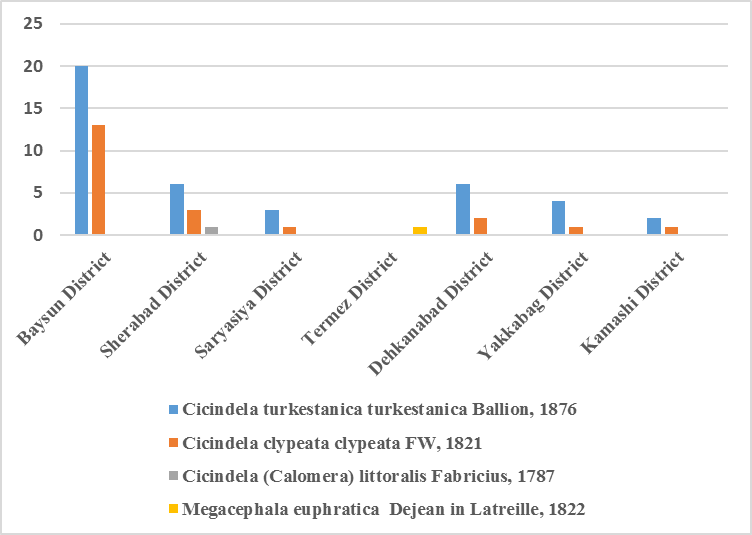 | Figure 3. Distribution of tiger beetles by region |
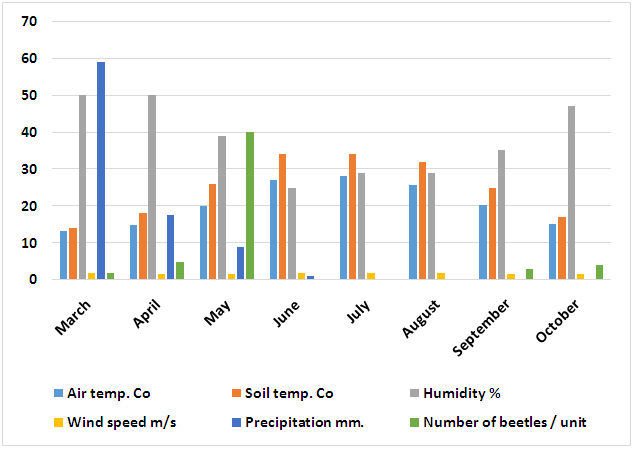 | Figure 4. Changes in the number of beetles depending on the physical parameters of atmospheric air (2023) |
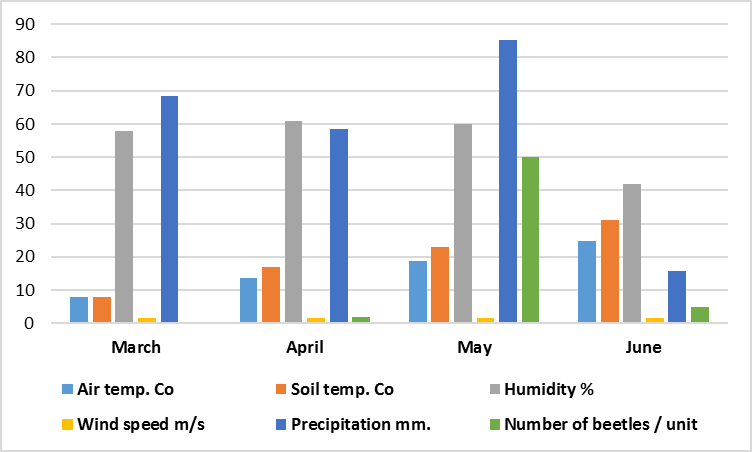 | Figure 5. Changes in the number of beetles depending on the physical parameters of atmospheric air (2024) |
4. Discussion
- As with many insect groups, the distribution and diversity of Cicindelidae is closely related to the geographical region of the world, climate and weather conditions, and habitat type [7,14,19]. It is known that the number of species of tiger beetles found in tropical regions is significantly higher than in temperate zones, and that lowland areas are characterized by greater species richness than highlands [1,5,8,16]. This is because such areas are characterized by high average annual temperatures, generally high humidity, and a significant diversity of sandy habitats that are favorable for many Cicindelidae species [12]. The fauna of tiger beetles of Uzbekistan was studied in detail by A. Dadamirzaev [20], and as a result of the studies, 364 species of tiger beetles belonging to 5 subfamilies, 23 tribes and 91 genera were recorded in the territories of the Republic. Tiger beetles were also studied as a subfamily within the Carabidae family [20; p. 169].Our study area includes the southern parts of Uzbekistan, namely Surkhandarya and Kashkadarya regions, which have the warmest climatic zone in the republic (summer is dry and hot).The article studies the extent to which the climatic and geographical conditions of Southern Uzbekistan affect the lifestyle of tiger beetles. These regions consist of diverse landscapes, and the tiger beetle species found there are common to Central Asia [11].In the studies on tiger beetles, soil parameters, including soil composition, moisture, and temperature, are tested after copulation and before oviposition in the soil. Such behavior allows them to select the optimal habitat type that can increase their reproductive success [4,10].Our results show that almost all of the studied Cicindelidae taxa (99% of the studied fauna) are diurnal species and were found to occur in similar environments, with only Megacephala euphratica Dejean Latreille, 1822 recorded as a nocturnal species in the desert area.
5. Conclusions
- The presence of narrow habitat specialization in the members of the Cicindelidae family studied during the research clearly confirms the high value of these beetle groups as important bioindicators and leading taxa for nature conservation. Of the listed species, Cicindela turkestanica turkestanica Ballion, 1876, Cicindela clypeata clypeata Fischar von Waldheim, 1821 are dominant in the region, but biotic and anthropogenic factors pose a significant threat to their populations, one of the greatest threats to the habitat of the species Megacephala euphratica Dejean in Latreille, 1822 and Cicindela (Calomera) littoralis Fabricius, 1787 is off-road vehicles that travel along sand dunes and river banks and destroy larval nests.Studies have shown that higher precipitation and associated soil moisture lead to an increase in the number of beetles in the imago state. If climate change-induced droughts in the region are predicted to become more severe, it will be important to better understand the beetles’ habitats and reduce their risk of extinction, to ensure that conservation efforts are effective, and to take steps to preserve natural ecosystems on a large scale.
 Abstract
Abstract Reference
Reference Full-Text PDF
Full-Text PDF Full-text HTML
Full-text HTML